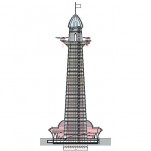Regulatory Requirements and Facts. Dynamic Analysis of High-Rise Buildings in Terms of Maximum Operating Basis Earthquake (OBE)

The article deals with developed technique of numerical simulation of the dynamic response of the “foundation - tall building” physically nonlinear spatial system with a certain combination of loads that include intensive seismic OBE impact that is provided by the earthquake accelerogram. The method that was implemented by the Abaqus verified software, is used for the finite element analysis of the design version of a 400-meter high skyscraper with reinforced concrete structures at a 9,5-scale seismic impact. Nevertheless, the major focus is on the modeling of reinforced concrete structures in the conditions of local damage - cracks and crumbling. The article reasonably concludes a premature and a methodological insecurity of regulatory requirements in terms of OBE calculations based on the significant types of nonlinearity.
Calculations of buildings and structures (especially unique ones) in terms of the seismic impact is an eternally relevant topic of research and development as well as practical applications. The targeted promotion in this direction is sometimes replaced by conditional and arbitrary decisions that cause a new round of debate and criticism.
Since July 2015, once updated SP 14.13330.2014 was officially commissioned, it has become obligatory to carry out the calculation of unique (including high altitude) and responsible structures and buildings in seismically active areas in terms of the maximum operating basis earthquake (OBE) that is provided by accelerograms, a direct dynamic method and with the account of the possible manifestations of the effects of physical, geometrical and constructive nonlinearity (inelastic deformations and local destructions). The main criterion and the most important task of such calculations are to prevent the collapse of the entire structure or its significant part.
It is easy to say but how can one do that? There is no clear answer in the regulations either. We have accumulated considerable international and domestic experience in direct dynamic analysis of nuclear and hydropower plants under seismic impacts, but most of these studies were performed in the linear elastic setting or with the account of a “simple” physical nonlinearity (e.g.: flexibility for well-studied structural metals).
Full content of this issue you can read here
The full version of the article can be read in our printed issue, also you can subscribe to the web-version of the magazine
 Written by: V. I. Travush, Deputy Director General of GORPROJECT, CJSC; Member of the Russian Academy of Architecture and Construction Sciences (RAACS), D.Sc. in Engineering, Professor;
Written by: V. I. Travush, Deputy Director General of GORPROJECT, CJSC; Member of the Russian Academy of Architecture and Construction Sciences (RAACS), D.Sc. in Engineering, Professor;
A.M., Belostotsky, Director General of STADYO R&D, the Head of REC CM MGSU,
Associate Member of RAASN, D.Sc. in Engineering, Professor;
Research Associates at the Research and Educational Center of Computer Simulation at MSUCE:
V. V. Vershinin, K.I. Ostrovsky, Phd in Science;
N.O. Petryashov; S. O. Petryashov


